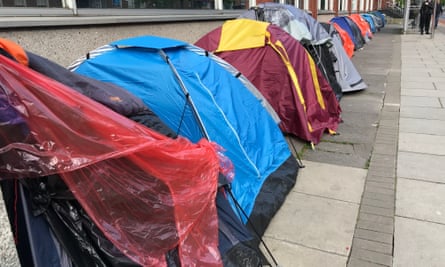Ireland’s newest refugee camp starts with a row of tents on the pavement at Mount Street and curves round an alleyway into a car park – about 60 tents in total in the heart of Dublin’s business district.
It began with a single tent in March outside the government’s International Protection Office (IPO) and grew week by week until forming this ragged, striking spectacle. The tents are a riot of colours. Some are new and taut, others torn and saggy. They huddle close to each other.
“There is power in numbers. It’s better to be with a lot of people,” said Lourens van den Burg, 36, an asylum applicant from South Africa. “You don’t want to be out camping on your own.”

The reason for that became apparent earlier this month when a crowd of protesters marched on the encampment chanting “Ireland for the Irish” and “You’re not welcome here”.
Hooded men attacked another, smaller encampment at nearby Sandwith Street and set fire to the tents, which were unoccupied. “That’s it lads, take it down,” said a voice in a social media post that showed men scattering the debris. “Take it all down. Make it unliveable.”
It was a stark manifestation of two crises that have collided in Ireland: a shortage of housing and a rise in refugees. An acute lack of affordable property – the government estimates a deficit of 250,000 homes – has fuelled homelessness and desperation in a growing population.
This has coincided with an influx of more than 70,000 Ukrainians fleeing Russia’s invasion, plus a record 13,651 asylum applications last year from people from other countries. Hotels, reception centres and other lodgings are overflowing, leaving about 500 asylum seekers on the streets.
“It wasn’t like I was expecting a mansion but I wasn’t expecting this. It’s my first time sleeping in a tent,” said Andile, a 30-year-old Zimbabwean who lives on Mount Street. He withheld his surname. He had thick socks to ward off the night-time chill and a stoic attitude. “You make do with what you have. If this is what it is, I’m fine as long as it’s safe.”
The taoiseach, Leo Varadkar, has expressed concern that there are not enough police to combat anti-immigration attacks. The Garda commissioner, Drew Harris, has said the force has sufficient resources for “operational integrity”.
Even non-violent protests require policing. Last week, residents of Inch, a town in County Clare, used tractors to blockade a road outside a facility housing 33 male refugees. After the government promised a four-week freeze on bringing further refugees, residents lifted the blockade but continued the protest. Some boarded a bus carrying asylum seekers to count and video them, drawing condemnation from migrant support groups.
The backlash against refugees and immigrants flared last year with pickets outside accommodation centres in Dublin and rural towns. Slogans such as #IrelandIsFull and #IrishLivesMatter appeared on placards at rallies and on social media. Agitators outside Ireland praised the protesters. Nigel Farage said the Irish were “speaking out”.
The Mount Street encampment has no facilities – people urinate into bottles – but offers safety in numbers, a police presence and ready access to the IPO, which processes asylum paperwork.

Most of the people in tents seem to be from Africa, the Middle East and Afghanistan. Homelessness charities provide showers and meals. “I can’t complain; I do eat and shower,” said Andile.
The march on the encampment and the attack at Sandwith Street had a silver lining, said Volodymyr, 46, from Ukraine. “It made us famous. The taoiseach even became aware of the situation.” Pending accommodation and permission to work, the challenge was to fill the time, maintain dignity and stay safe, he said. “You spend the day wandering around the city looking for a socket to charge your phone.”
